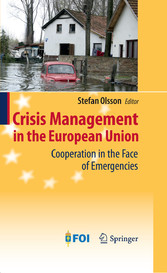Suchen und Finden
187200_1_En_FM_OnlinePDF
2
Preface
5
Contents
5
About the Authors
5
Abbreviations
5
187200_1_En_1_Chapter_OnlinePDF
13
Chapter 1: Understanding the Crisis Management System of the European Union
13
Introduction
13
Crisis Management By and For the Union
14
The Emergence of a Crisis Management System
16
The Added Value of Cooperation at the EU Level
18
Potential Problems with Cooperation at the EU Level
20
Introducing the European Union's Crisis Management System - a Map
21
The Crisis Management Cycle as a Conceptual Framework
21
Arrangements, Institutions or Structures?
25
The Organisation of the Book: The Chapters
25
References
27
187200_1_En_2_Chapter_OnlinePDF
29
Chapter 2: The EU Policy-Making Process and Crisis Management
29
Introducing the EU Policy-Making Process of Today
30
The Lisbon Treaty and the EU Policy-Making Process
34
Taking the Initiative: The Primacy of the Commission
36
Council Decision Making: From Unanimity to Qualified Majority
40
Enhanced Role for the European Parliament
42
Implementation by the Commission and the Member States
44
Concluding Remarks on Future Trends
45
References
46
187200_1_En_3_Chapter_OnlinePDF
48
Chapter 3: The European Programme for Critical Infrastructure ProtectionEuropean Programme for Critical Infrastructure Protecti
48
Introduction: Protecting ECI
49
The EU and CIP
50
CIP at Member State Level
51
Identification and Designation of European Critical Infrastructure
54
Obligations that Follows with an ECI-designation
57
Obligations for Owners and Operators of a Designated ECI
57
Obligations for the Member States and their Governmental Ministries and Authorities
58
The Critical Infrastructure Warning Information NetworkThe Critical Infrastructure Warning Information NetworkCIWIN49The secti
61
The Annual Financial Programme for Prevention, Preparedness and Consequence Management of Terrorism59The section is built on A
63
The European Reference Network for Critical Infrastructure ProtectionThe European Reference Network for Critical Infrastructur
65
The EU Member States’ Views on EPCIP Differ
66
Concluding Remarks: The EU as an Influential CIP-Player
68
References
69
187200_1_En_4_Chapter_OnlinePDF
71
Chapter 4: Rapid Alerts for Crises at the EU Level
71
Serious Incidents in the Field of Civil Protection
73
Radiological Emergencies
75
Biological and Chemical Threats
77
Contagious Diseases in Humans
78
Threats to Animal Health
80
Threats to Plant Health
82
Threats in Food and Feed
83
Threats to Consumer Health and Safety
85
Threats Against Critical Infrastructures
87
Commission Coordination During a Major Cross-Sectoral Crisis
88
Concluding Remarks
90
References
91
187200_1_En_5_Chapter_OnlinePDF
93
5: The Community Mechanism for Civil Protection and the European Union Solidarity Fund
93
The Community Mechanism for Civil Protection
94
The Evolvement of the EU's Cooperation within Civil Protection
94
The Mechanism and its Different Components
96
The Mechanism and Other Actors
99
The Mechanism in Practice
101
Possible Added Values and Weaknesses of the Mechanism
104
The European Union Solidarity FundEuropean Union Solidarity Fund
105
Background
105
The Solidarity Fund
105
Implementing the Solidarity Fund
107
Development of the Solidarity Fund
109
Civil Protection: Differing Perspectives
110
EU-Institutional Positions
111
Member States' Point of View
113
Concluding Remarks
114
References
115
187200_1_En_6_Chapter_OnlinePDF
118
Chapter 6: EU Consular Cooperation in Crisis Situations
118
The Need for Community Action: The Development of the EU Consular Crisis Management Cooperation
120
The Institutional Framework
120
The EU Consular Crisis Management Cooperation Put into Practice
123
Consular Cooperation on Crisis Managementwith Third Parties
128
Initiatives to Strengthen the EU Consular Cooperation on Crisis Management
128
Concluding Remarks: The Future of EU Consular Crisis Management Cooperation
131
References
134
187200_1_En_7_Chapter_OnlinePDF
136
7: The Crisis Coordination Arrangements (CCA)
136
The CCA and Its Importance for the Member States and the EU
137
The Aim and Purpose of the CCA
138
The Crisis Steering Group
139
The Composition of the Crisis Steering Group
140
The Support Group of the Crisis Steering Group
141
When and How to Activate the Crisis Steering Group
141
The Agenda for the Initial Meeting of the Crisis Steering Group
142
When and How to Deactivate the Crisis Steering Group
144
The CCA at the Test
144
Demands on the Member States Raised by the CCA
145
Concluding Remarks
146
References
147
187200_1_En_8_Chapter_OnlinePDF
148
Chapter 8: Counter-terrorism in the European Union
148
From Humble Initiatives to a Comprehensive Strategy
149
The Policy and Legal Framework
151
Mapping the Actors in the Field
154
The Institutions
154
EU Bodies in the Area of Freedom, Security and Justice
155
EU Bodies Outside the Area of Freedom, Security and Justice
156
How Can the EU Act?
157
Prevent
158
Protect
159
Pursue
159
Respond
160
Concluding Remarks: Future Challenges
160
References
163
187200_1_En_9_Chapter_OnlinePDF
165
Chapter 9: The Future of Crisis Management within the European Union
165
The European Union and the Crisis Management Cycle
165
The Treaty of Lisbon
168
The European Union as a Crisis Manager
171
References
175
187200_1_En_Index_OnlinePDF
176
: Index
176
Alle Preise verstehen sich inklusive der gesetzlichen MwSt.









